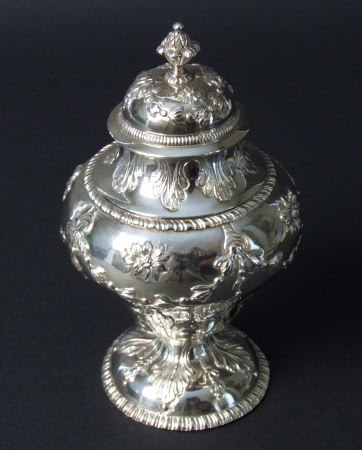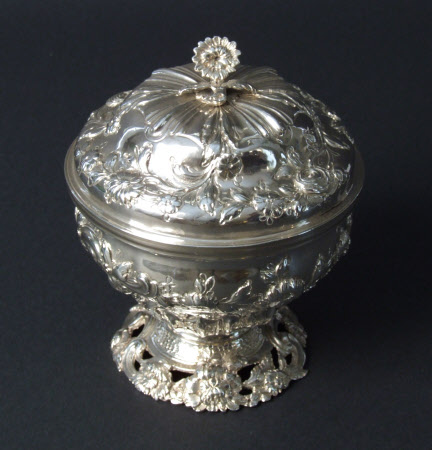Tea canisters and sugar box
Samuel Taylor
Category
Silver
Date
1763 - 1771
Materials
Sterling silver
Measurements
Heights: 16.5 cm (canisters) and 12.5 cm (sugar box). Weight of set: 26.4 oz t
Place of origin
London
Order this imageCollection
Polesden Lacey, Surrey
NT 1246849
Summary
Pair of tea canisters, 1770/1, and sugar box, 1763/4, all sterling silver and by Samuel Taylor, London. The inverted pear-shaped body of each canister is raised and chased with floral swags and drops suspended from rings issuing from cornucopia. Above is a gadrooned moulding and the swags are interspersed by single flower-heads whilst below are acanthus leaves. The domed foot and concave neck, also raised, is applied and chased with further acanthus leaves. On the foot, which has a chased gadrooned rim, the leaves terminate in spherical drops and are interspersed with further floral drops. The lid is raised in domed form with chased floral swags and flower-heads to match the body. It has a broad, plain rim and a narrow band of gadrooning at the intersection. There is a cast calyx finial. The raised body of the sugar box is also an inverted pear-shape and has a plain lip moulding. It and the flattened, ogee-domed cover are chased with scrolls, flowers, foliage, shellwork and fluting. There is an applied sunflower finial to the cover. The applied, domed foot is cast and has a pierced outer band of scrolls and flowers and an inner band of chased matting. The canisters and box are contained within a later fitted rosewood case with silver mounts and a faded red velvet lining (NT 1246191). The mounts are hallmarked for 1840 (?) and have the maker’s mark of Charles Reily and George Storer. Heraldry: None (though the later case, NT 1246191, is engraved with an unidentified crest). Scratchweights: None. Hallmarks: Each of the canisters is fully marked on the underside with the maker’s mark ST in script in a heart-shaped punch for Samuel Taylor (Arthur Grimwade, London Goldsmiths 1697-1837, 1990, no. 2645), date letter ‘P’, leopard’s head crowned and lion passant. The sugar box is marked on the underside with the same maker’s mark, date letter ‘H’, leopard’s head crowned and lion passant.
Full description
Apart from dinner and supper, it was the service of tea that provided the principal opportunity to display wealth, status and fashionability through silver in eighteenth century Britain and Ireland. Tea was offered to visitors at all times of day and most of the elements of the associated equipage could be acquired in silver if the purchaser was wealthy enough - tea spoons, sugar tongs, strainer spoons, slop basins, tea pots plus waiters to place them on, tea kettles, cream ewers, sugar boxes, canisters for the leaves and, to contain the whole ensemble other than the kettle, large salvers (known then as tables).[1] Precise protocol evolved with the most senior woman of the household presiding and making and pouring the tea, and the next most senior woman distributing the cups. The placing of a silver teaspoon within the cup indicated to the host that replenishment was not required. Tea continued to be one of the most important elements of high society life into the twentieth century and Margaret Greville presided much as had her precursors as society hostesses two hundred years previously. At Polesden it was taken either in the Saloon or, for smaller gatherings, in the adjoining Tea Room and, according to Harold Nicolson, Queen Mary would often telephone Mrs Greville out of the blue ‘announcing herself for tea’.[2] Another habitué, the author Beverley Nicholls, considered the Polesden tea table: ‘the grandest, most formidable, most glittering, and altogether the most impressive ... Tea is at 5 o’clock, and at Polesden, 5 o’clock means 5 o’clock and not 5 minutes past. Which in turn means that the Spanish ambassador, who has gone for a walk down the yew avenue, hastily retraces his steps, and that the Chancellor of the Exchequer ... hurries down the great staircase, and that the various ladies belonging to these gentlemen rise from their chaises longues on which they have been resting in their bedrooms ... and join the procession to the tea-table which is set out in one of the smaller drawing rooms. The teapots, cream-jugs, the milk pots and the sugar basins are of Queen Anne silver; the tea service is Meissen; and the doyleys, heavy monogrammed, are of Chantilly lace’.[3] In fact Mrs Greville's tea silver was predominantly Georgian and it included this matched set of canisters and sugar box by Samuel Taylor which must have been brought together in the mid 19th century when the associated rosewood box was made (NT 1246191) to contain it. A silver mount atop the box is engraved with the crest of a hawk or falcon rising proper and belled but as this was borne by numerous families it does not pinpoint the then owner [4]. Whether Mrs Greville acquired the pieces or inherited them from her father is not known. They are recorded as being at Polesden Lacey in the probate valuation of 1943, following her death the previous year. Samuel Taylor (fl. 1744-73) is associated almost exclusively with tea canisters and sugar boxes and his work is marked out by a profuse use of delicate floral chasing.[5] Arthur Grimwade considered this was rendered ‘somewhat monotonous’ by its constant use [6] but it is deployed effectively, is generally varied in its application and it evolved with fashion over the period of his practice. Thus the sugar box of 1763/4 is decidedly asymmetric and rococo in its decoration whereas that of the canisters of 1770/1 is more controlled and reflects the advent of the neo-classical. James Rothwell, National Curator, Decorative Arts March, 2023 Notes: [1] James Rothwell, Silver for Entertaining: The Ickworth Collection, 2017, p. 98. [2] Christopher Rowell, Polesden Lacey, 2008, p. 75. [3] Beverley Nichols, Down the Kitchen Sink, 1974, p. ?? [4] James Fairbairn, Fairbairn’s Crests of the Families of Great Britain and Ireland, 1968, plate 105, no. 4. [5] For another set of canisters and sugar box by Samuel Taylor, all of 1751/2, see Timothy Schroder, British and Continental Gold and Silver in the Ashmolean Museum, 2009, vol. 2, cat. 304, pp. 792-3. [6] Arthur Grimwade, London Goldsmiths 1697-1837, 1990, p. 678.
Provenance
Probably acquired by Margaret Anderson, the Hon. Mrs Ronald Greville, DBE (1863-1942); recorded as having been at Polesden Lacey in the 1943 probate valuation following Mrs Greville’s death; bequeathed with Polesden Lacey to the National Trust in memory of Mrs Greville’s father, William McEwan (1827-1913).
Credit line
Polesden Lacey, the Greville Collection (National Trust)
Makers and roles
Samuel Taylor, goldsmith




